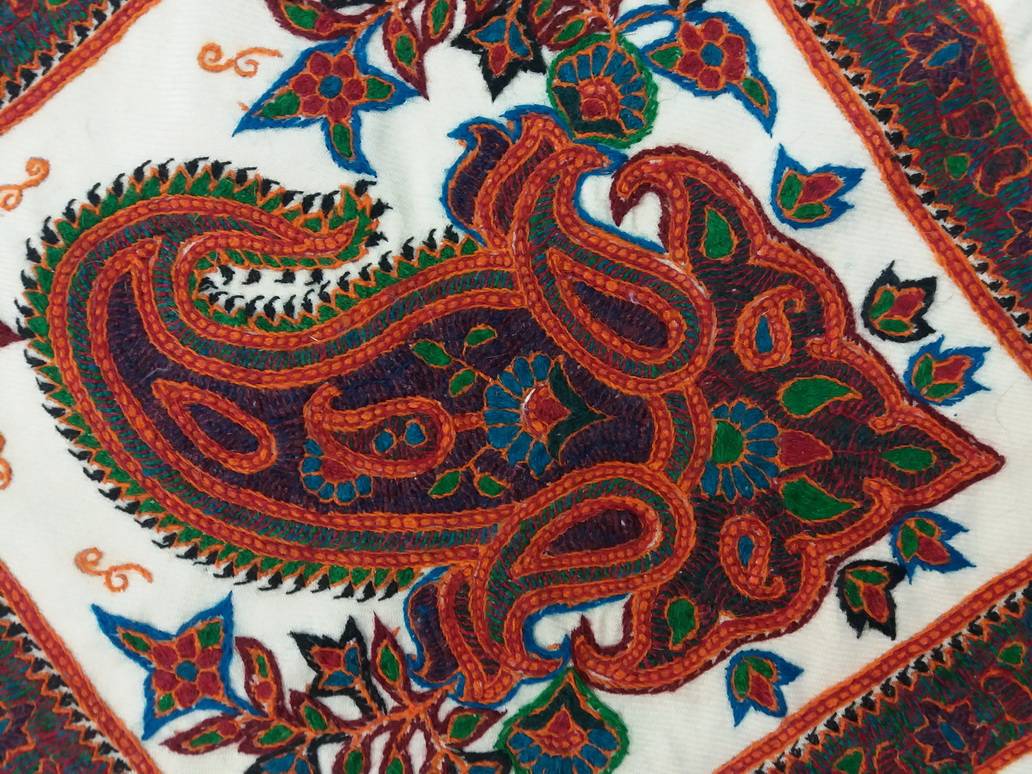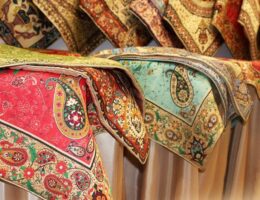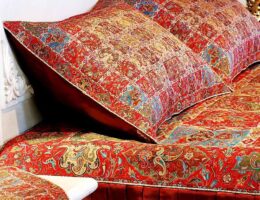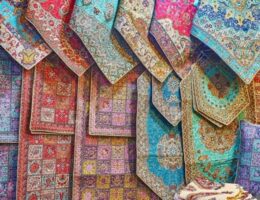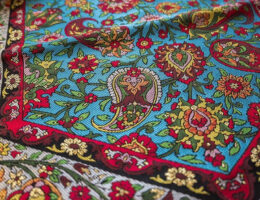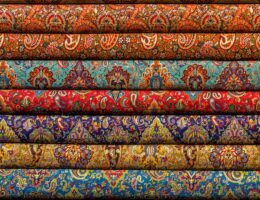IRAN ART EXHIBITION: KERMAN IS FAMOUS FOR ITS PATTEH CRAFTS
Pateh originates from Kerman in the south of Iran and is worked by women . The earliest Pateh dates back to the 18 the century . It goes further back but wool does not keep well, therefore we have little remaining evidence.
Pateh consist of a woolen fabric or shawl called ‘Arriz’ اریز and the embroidery threads which as usually of the same woolen yarns.
It is a folk art needlework which means that the objects usually have a practical use . There are 8 traditional colour yarns and is usually worked on a red or white background . Although in recent years working on orange , turquoise and navy backgrounds has become popular .The designs are traditional and most definitely have their origin in the carpert designs of the area. Paisley patterns بتجقه the central Toranj design and the Tree of Life are familiar designs used in Pateh Doozi .
The goat wool that is produced in Kerman goes back to Roman times and before . It was called Carmenian Wool and was prized for centuries and raised a high price. Pashmina is now forbidden due to the fact that the pulling of the down from the undercoat and behind the ears of the animal and is considered cruel. The fleeces are now sheered off in Australia, China and Iran but some illegal pulling still goes on in Pakistan and India. . Fleecing occurs and is produced and spun in Kerman but the Pasmina producing goat is now an endangered species. These days , the Merino Sheep wool is used for both carpets and crafts.
The word Pashmina comes from the Farsi word ”pashm” which means wool and is the name of the fine fluffy wool that is harvested from the neck region and behind the ears of the goats. Due to the very cold climate the goats have developed a double fleece which molts in the Spring and can be easily combed from the animal.
There are often inquiries as to which came first , the Indian /Kashmir woolen industry or the Iranian . The fact is the Iranian export was really taken on and expanded in a superb way in India and became dominant during the 18 th and 19th century as trade with the British Colonial power boomed.
The story starts with the Central Asian Mountain Goat.
A sufi called “Seyyed Ali Hamedani” from Hamedan, Iran ,travelled several times to what we now call Kashmir but was then know as Ladakh region of India in the year 713 . He recognised a similar kind of goat to the Central Iranian Plains and decided to harvest the wool as he had seen in his home country , spin it and knit a pair of socks which he presented to the king .Sultan Qutabdin was so impressed with their warmth he requested Hamedani to go back to Iran and bring the industry to Ladakh . It is said that Hamedani took over 700 artisans from Iran , from breeder, spinners, weavers and stitchers and a whole industry began .
In 2014 , The United Nations agency Unesco reported and honoured. Mir Seyyed Ali Hamedani as one of the principle figures who shaped the culture of Kashmir both architecturally and through the flourishing of arts and crafts and hence the economy. The skills and knowledge he brought from Iran to Ladakh gave rise to a whole industry.
IRAN ART EXHIBITION: The Boteh design which is familiar to all Iranian crafts from carpets to the shawls is what we call in the West , the Paisley design . It is described as a tear shape but the motif is actually derived from the evergreen tree , Sarv . The anglicanisation of the name came about as the shawl weaving industry took shape in Paisley ,Glasgow in the 19th century .
These shawls were replicas of the Indian Kashmiri shawls and were being mass produced in Renfrewshire ,Scotland as the industrial revolution brought in the Jaquard looms . The shawls were extremely popular during Victorian times and became a fashion statement for the women of the day .
The wool used in Kerman for Pateh Doozi today varies from the same local wool spun and dyed locally or imported wool from Australia. The yarns are both chemically and naturally dyed but are used separately as the naturally dyed yarn pieces are more expensive and are usually of a more finely spun count.
Pateh takes many of its designs from the famous Kerman carpets designs and similarity can be seen clearly as to a central mandala with borders. Kerman in situated in a dry desert plain and has severely cold winters and hot summers. Life is spent indoors and therefore the art and crafts have replaced flowers, gardens , birds etc… with their weaving and stitching and brought them into their homes.
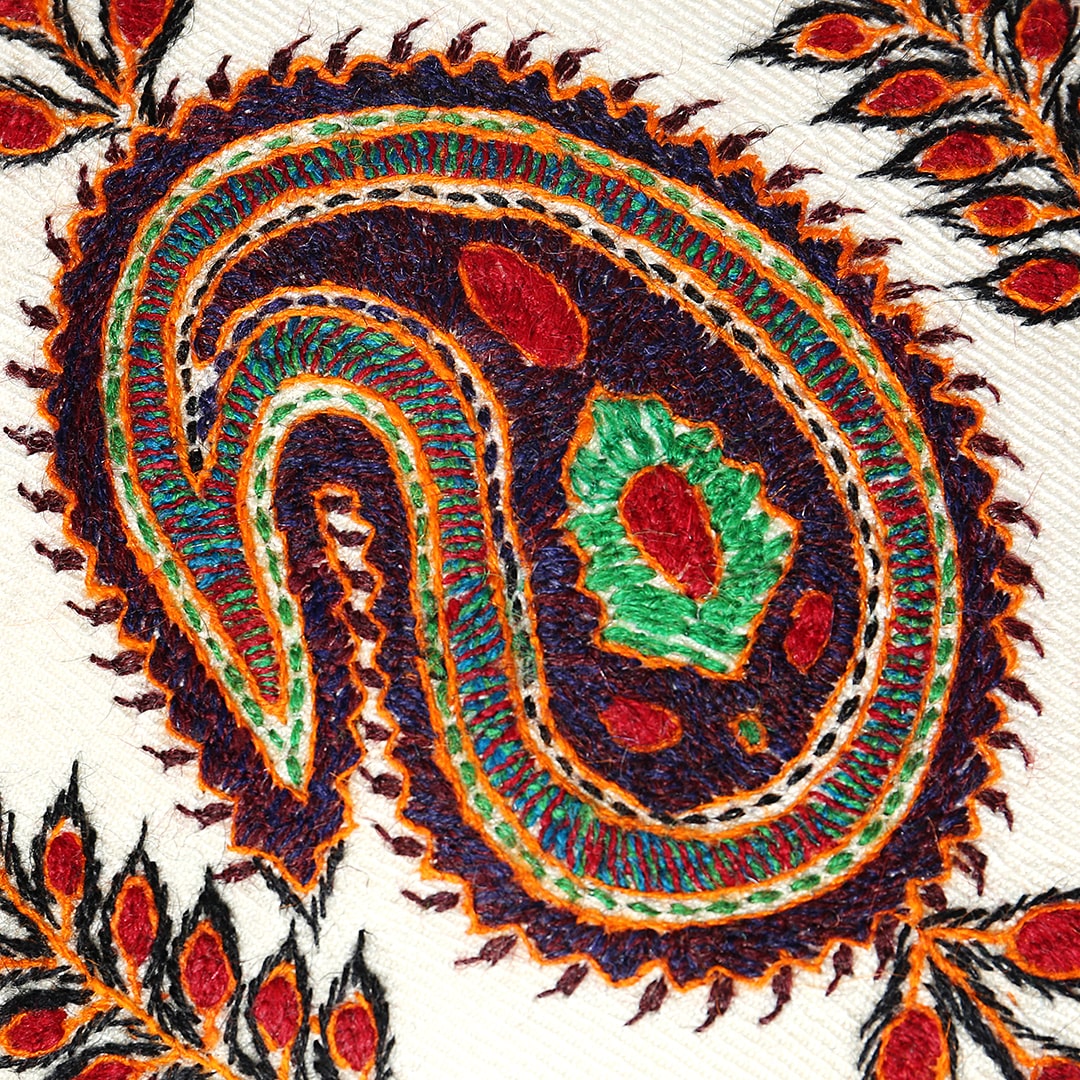
Pateh Douzi, also known as “Selseleh Douzi” or “Fateh Douzi” is an important handicraft of Kerman province. Fortunately, this craft is still being practiced and making Patehs is one of the most flourishing trades of Iran. Due to vulnerability of textiles no Pateh product has survived from the ancient times, and very little is known about its history. However, according to travel documentaries and texts that belong to Safavid dynasty, we can be almost certain that Pateh was quite popular in Kerman during that time.
IRAN ART EXHIBITION: Pateh Douzi, or art of sewing Pateh, is a kind of embroidery in which all over of the textile is covered by colorful stitches. The makers of Pateh are most commonly young girls and women of Kerman who sew the patterns from their own imagination on wide and thick fabrics called “Ariz” or “Shawl”. Ariz is a kind of handmade fabric that in the past was used to make skirts, coats and women overcoats. This fabric is made by textile machinery, both manual and automatic, in colors such as red, yellow, white, blue and green. “Ris” or the yarn that is used in Pateh is a wool yarn that was handspun in the past but today it is spun by machines. Traditionally the yarns are dyed with colors such as burgundy, black, light or dark green, yellow, orange, red, dark blue and etc., but new colors have been added to Pateh color palettes. In the past, Golabatoon and silk yarns were used, too.
One of the oldest surviving pieces of Pateh, which belongs to 1869, was used as the cover of Shah Nimatullah Wali’s tombstone. This work is a great and elaborate sample of this craft. Sixteen skillful women of Kerman worked for two years and applied this Pateh by stitching colorful silk yarns on a cream wool fabric. One of the traits of Pateh which adds to its beauty and delicacy is the traditional motif of tree of life or “Boteh Jegheh”, paisley. It is one of the most popular Iranian motif.
Today Pateh is most common in cities such as Kerman, Sirjan and Rafsanjan, and is used to make tablecloth, cover of holy Quran, curtains, cushions, bed covers, decorating parts of clothing and traditional dolls. Pateh has long been considered a part of dowry of young girls of Kerman and this is one of the reasons why it has kept thriving until today.
